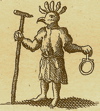
Three years after the publication of Albert Einstein’s seminal Special Theory of Relativity (1905), his mentor and one-time teacher, Hermann Minkowski, gave a lecture in Cologne elaborating on his former student’s findings, beginning with the proclamation that,
Henceforth space by itself, and time by itself, are doomed to fade away into mere shadows, and only a kind of union of the two will preserve an independent reality.What Minkowski couldn’t predict was how painfully long it would take for our Newtonian belief in fixed time to actually fade into mere shadows. As the twentieth century unfolded, fixed time only became more entrenched, largely because it proved so useful a tool in promoting our singular march toward Progress.
As I’ve discussed in previous posts, there are cultures for whom space and time never suffered the humiliation of separation, Aboriginal Australia chief among them. Here the Dreaming maintains a union of the two, where there is only place to consider.
Einstein would seem to concur, once stating, “The distinction between past, present and future is only an illusion, even if a stubborn one.” To remove Einstein’s theory from the theoretical and prove it, of course, meant doing things like sending a twenty-year-old identical twin off in a rocket at very nearly the speed of light for two years (in his time), and have him return to find his brother a very old man living comfortably in Tucson, Arizona with the rest of the feeble old scientists who had shot him off into the ether seventy years earlier (in their time) in the first place.
The truth that rested in his theory of relativity also provided the unwanted proof of what an oily calm modern man had been sailing headlong into, somewhere en route ordaining the rest of the world should run adrift with him.
Despite the lingering influence of those such as Heidegger — with his modified Newtonian view of the present — it should have been apparent that in a world of space-time, the past, the present and the future all do exist quite simultaneously.
What modern man failed to realise Einstein was saying, was that time and space aren’t fixed or readily determinable; they are, in fact, infinitely variable. And while they do exist in a relative sense, there is nothing absolute in their nature. They are instead interwoven, making one quite inseparable from the other. So time exists for me in the space I occupy, and time exists for you in the space you occupy, but there are no grounds for the worn-out belief that time exists commonly and universally for the both of us.
That which modern man has known and thought of as time for so long is certainly no less real than the printing press or the motor car, but nor is it any less a product of his own invention.
Returning to Roger and Ruth’s question, “Is modernity our antiquity?” then, in terms of the world-view they perpetuate they could just as well be one in same. The failed linearity of time is inherent and intrinsic to both.
 Documenta 12 artistic director Roger M. Buergel offers members of the press a guided tour of exhibition venues earlier today in Kassel.
Documenta 12 artistic director Roger M. Buergel offers members of the press a guided tour of exhibition venues earlier today in Kassel. 



